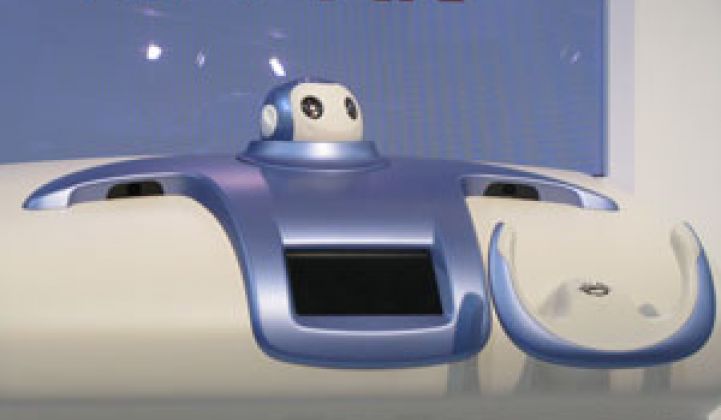Can you charge an electric car without plugging it in? Nissan is looking into it.
Researchers at the Japanese automaker are trying to see if there is a way to charge the batteries in electric cars while the car is driving without using gas, said Minoru Shinohara, senior vice president of the technology development department at Nissan, in an interview at Ceatec last month. The car would function like a Chevy Volt, but it wouldn't have a gas generator.
"Electric charging without a connection," he said, "it is very [futuristic], but we need zero emission vehicles. ... With India, Russia and China, there is a large increase in vehicles expected."
One potential option: ultracapacitors. APowerCap from the Ukraine is working on ultracapacitor chargers for cars. Like Toyota, Nissan could also explore hydrogen.
Although he doesn't pop up in the U.S. press much, Shinohara's is a name to look for when trying to ferret trends from the Japanese auto industry. In October 2007, he revealed in an interview that the company had little interest in biofuels. Instead, it saw the future of cars in electricity, adding that Nissan planned to release plug-in hybrids by 2010 and all-electric cars by 2011. It was a good signal: seven months later, CEO Carlos Ghosn "announced" Nissan's electric car plans.
Here's what else is on his mind these days:
Nissan's push into electric cars will be broad. The company's first electric cars, to be released in Japan and the U.S. in 2010, will be city cars. But after that consumers will likely see sedans and possibly sports cars. That amplifies the company's stance: last year, Nissan saw electrics as commuter vehicles that wouldn't directly compete in the broader market against gas-guzzlers.
"We are aiming for EV leadership, which means we need to cover the market," he said. "Which means we need to prepare several vehicles."
Still, even with the excitement around electric cars, selling commuter cars will require a good dose of consumer education.
Plans for a plug-in hybrid are off the front burner at the moment. Last year, plug-ins were at the top of the schedule. "The electric car is the ultimate solution," Shinohara said.
Pricing, weight, charging infrastructure and charge time remain major obstacles to electric cars. Japan, however, seems to be taking an active role in engineering a conversion. The country is looking at kilowatt-range charging stations that can cut charge time to 30 minutes. "Then, at nighttime, with low priced electricity, you can charge it for five to six hours" with conventional outlets, he said. Nissan is also looking at battery swaps.
Rebates are big here too. One idea making the rounds is a federal government program that could cover 50 percent of the cost of a car. With local rebates, close to 25 percent of the cost of an electric car – conceivably – could be covered.
Watch out for a push on the Eco-pedal. The gas pedal provides greater resistance to a person's foot when accelerating begins to reduce gas mileage. The force-feedback technique won't prevent drivers from accelerating, but instead offer a reminder that the car is burning more fuel. Early tests show it can increase mileage by 5 percent or more. It comes to Japan very soon and likely other parts of the world later.
Finally Shinohara said that robotic accident prevention is improving. Automakers are working on devices that will take control of a car right before an accident. "It will be applied in a very restricted manner, when people can't react quickly," he said.
Nissan and scientists at the University of Tokyo also are studying bees, which rarely collide with each other, to see if biomimicry can solve the problem.
Join industry leaders and influencers at Greentech Media's new conference series Greentech Innovations: End-to-End Electricity on November 17 and 18 in New York City.



